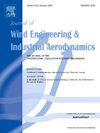量化强风下输电塔线系统耦合效应的工程方法
IF 4.2
2区 工程技术
Q1 ENGINEERING, CIVIL
Journal of Wind Engineering and Industrial Aerodynamics
Pub Date : 2024-11-12
DOI:10.1016/j.jweia.2024.105954
引用次数: 0
摘要
对于输电塔线(TL)系统而言,强风下线路电缆与塔之间的耦合效应非常明显。本文提出了一种量化耦合效应的方法。假定线路电缆和杆塔可以实现有效分离,本文将耦合效应转化为从线路电缆到目标杆塔的传递载荷、线路电缆的耦合参与质量和附加阻尼。通过优化方法定义了有效的分离条件,使分离体和 TL 系统之间风致响应和动态特性的残余误差最小化。我们考虑了一个典型的 TL 系统,并对其结构动态特性和风致响应进行了分析。特别是对与 TL 系统耦合效应相关的量进行了估算。结果表明,在现行规范中被忽视的平行于线路电缆的转移动载荷分量非常重要,而且对线路电缆的分离边界条件非常敏感。此外,导体的耦合参与质量比接地线的耦合参与质量更为突出。所提出的方法可用于量化 TL 耦合效应,并将其纳入输电线路结构的风致响应分析。本文章由计算机程序翻译,如有差异,请以英文原文为准。
Engineering method for quantifying the coupling effect of transmission tower-line system under strong winds
For transmission tower-line (TL) systems, the coupling effect between line cables and towers under strong winds is significant. This paper presents a method to quantify the coupling effect. Assuming that effective separation of line cables and towers is attainable, this work transforms the coupling effect into the transferred load from the line cable to the target tower, the coupling participation mass of the line cable, and the additional damping. The effective separation conditions are defined through an optimization method minimizing the residual errors of the wind-induced response and dynamic characteristics between the separated bodies and the TL system. A typical TL system is considered and analyzed for its structural dynamic characteristics and wind-induced response. Particularly, the quantities associated with the coupling effect of the TL system are estimated. It reveals that the transferred dynamic load component parallel to the line cable which is overlooked in current codes is significant and highly sensitive to the separation boundary conditions of line cables. Furthermore, the coupling participation mass of the conductor is more prominent than that of the ground wire. The proposed method is feasible for quantifying the TL coupling effect and incorporating it into the wind-induced response analysis of transmission line structures.
求助全文
通过发布文献求助,成功后即可免费获取论文全文。
去求助
来源期刊
CiteScore
8.90
自引率
22.90%
发文量
306
审稿时长
4.4 months
期刊介绍:
The objective of the journal is to provide a means for the publication and interchange of information, on an international basis, on all those aspects of wind engineering that are included in the activities of the International Association for Wind Engineering http://www.iawe.org/. These are: social and economic impact of wind effects; wind characteristics and structure, local wind environments, wind loads and structural response, diffusion, pollutant dispersion and matter transport, wind effects on building heat loss and ventilation, wind effects on transport systems, aerodynamic aspects of wind energy generation, and codification of wind effects.
Papers on these subjects describing full-scale measurements, wind-tunnel simulation studies, computational or theoretical methods are published, as well as papers dealing with the development of techniques and apparatus for wind engineering experiments.

 求助内容:
求助内容: 应助结果提醒方式:
应助结果提醒方式:


